
What to Do in Lisbon, Portugal’s Colorful Capital City
March 27, 2024
Pallavi is a Los Angeles and Mumbai-based freelance journalist. She writes about design, travel, and lifestyle for leading publications like Travel & Leisure, Architectural Digest, Conde Nast Traveller, GQ, Thrillist, and Observer. An avid traveler and design enthusiast, she finds inspiration in everything she encounters, be it her immediate environment or her travels around the world.
The picturesque capital city of Portugal, Lisbon, is home to seven rolling hills and the majestic Tagus River. The metropolis is layered in history. One of Europe’s oldest, it boasts cobbled streets, brightly tiled buildings, UNESCO World Heritage sites showcasing 16th-century architecture, eye-catching natural beauty, and vibrant Portuguese culture.
In Lisbon, explore the world heritage sites, or wander Alfama (Lisbon’s oldest neighborhood’s) cobbled streets. Indulge in fresh seafood and immerse yourself in melancholic Fado music. Don’t skip a visit to the Belém district, where you’ll find some of the city’s most impressive historic monuments and thoughtfully designed parks and gardens. Lisbon offers a kaleidoscope of old-world charm, breathtaking scenery on the Tagus River, and young, modern energy. Here’s the ultimate guide for what to do in Lisbon.
What to Do in Lisbon
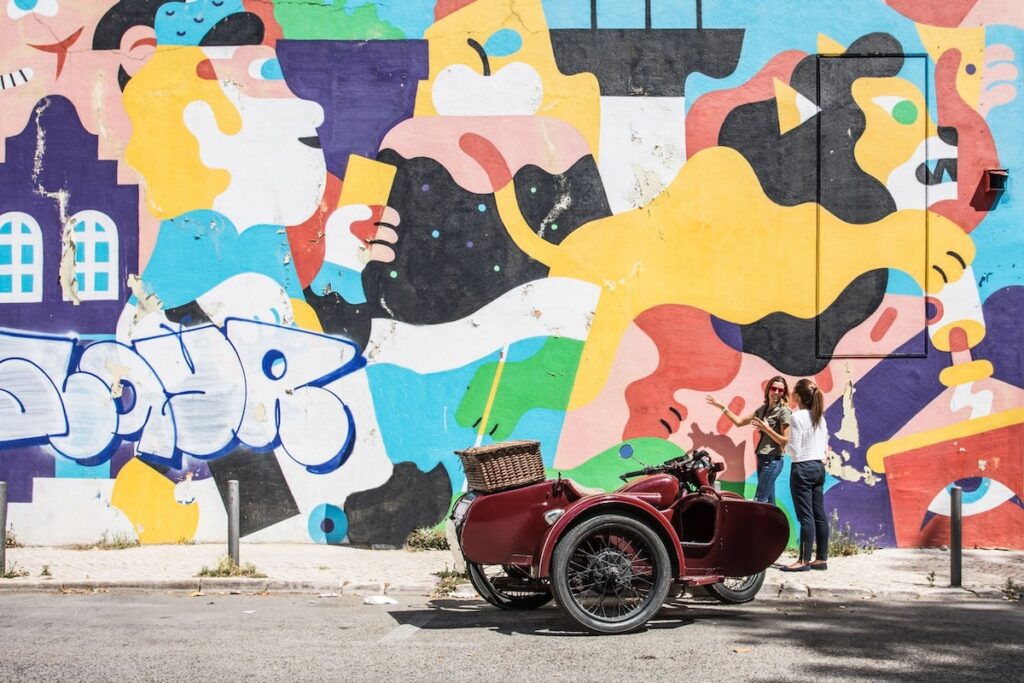
Begin your Portuguese getaway with a vintage moto-sidecar tour of the landmarks of Lisbon. This distinctive tour offers a fun and memorable way to soak up the city’s atmosphere, enabling you to see it from a different perspective. These trips typically include Lisbon’s historic center, which is home to the Avenida da Liberdade (luxury shopping avenue), Miradouro Santa Luzia (scenic viewpoint), Chiado (main square of Lisbon), Praça do Comércio (riverside historical landmark) and the Alfama district.
While in Lisbon, you have to ride on one of the city’s iconic yellow trams. These age-old trams are a relaxed and scenic way to see the city, and they’re a great way to get around if you need a break from walking. Take the Tram 28 route, which winds its way through some of Lisbon’s most personality-filled districts.
Thereafter, go for a sunset sail on the Tagus River. A boat tour of Lisbon is a sensory overload in the best way possible. Picture sailing along the water as the golden light bathes historic landmarks of the city such as Belém Tower and the 25th of April Bridge. It’s a leisurely way to see the city, perfect to not overwhelm a first-time visitor.
In addition, explore the Belém Discovery area, which is home to several heritage sites such as the Jerónimos Monastery, the Tower of Belém (both are UNESCO world heritage sites), and the Discoveries monument. The Jerónimos Monastery is an excellent example of Manueline architecture, and it’s one of the most distinctive monuments in Lisbon. The Belém Tower, a fortified tower on the banks of the Tagus River, is another must-see.
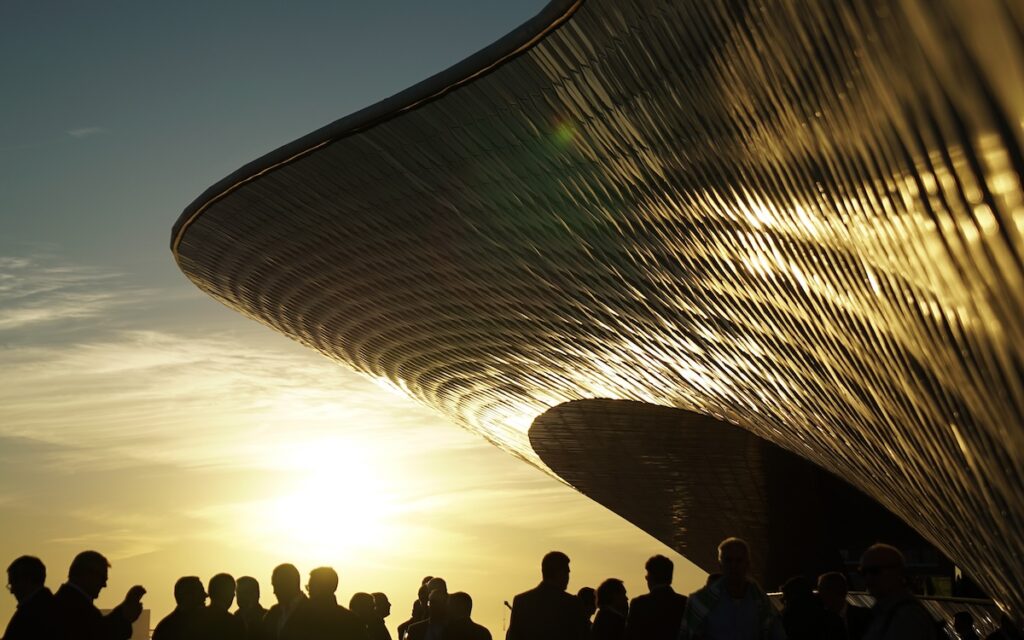
Finally, end your sightseeing excursion with a walking tour of Parque das Nações, the newest neighborhood of Lisbon. This riverside district boasts verdant gardens with striking public art, modern buildings, renowned restaurants, and shopping malls. I suggest checking out Oceanário de Lisboa, the largest indoor aquarium in Europe, which houses one-of-a-kind marine species. Additionally, if you’re interested in path-breaking contemporary art and design, MAAT (Museum of Art, Architecture and Technology) is the place to go. This museum on the riverfront features a futuristic form and is home to a range of temporary exhibitions and special events, as well as a permanent collection of Portuguese and global art.
Where to Shop
The city of Lisbon offers a delightful mix of shopping options, from upscale designers to chic local stores to bustling flea markets. If you were to choose a starting point for your shopping adventures, opt for the Avenida da Liberdade, in the heart of the city. Avenida da Liberdade is Lisbon’s most prestigious shopping street, lined with luxury designer stores such as Prada, Louis Vuitton, and Chanel.
Alternatively, if you feel like going off the beaten path and discovering local favorites, check out Bairro Alto, the bohemian district full of independent shops selling everything from vintage clothing and handmade jewelry to Portuguese cork products and food. Bairro Alto dates back to 1513 and the streets are steeped in its rich history.
I also loved LX Factory, a former industrial complex, that has been transformed into a creative hub with shops retailing contemporary home furnishings, clothes, and artifacts by local designers. Moreover, Feira da Ladra, Lisbon’s popular flea market is held every Tuesday and Saturday in the Campo de Santa Clara. Think winding stalls, as far as the eye can see, overflowing with rare antiques, handcrafted collectibles, and delicate silver jewelry.
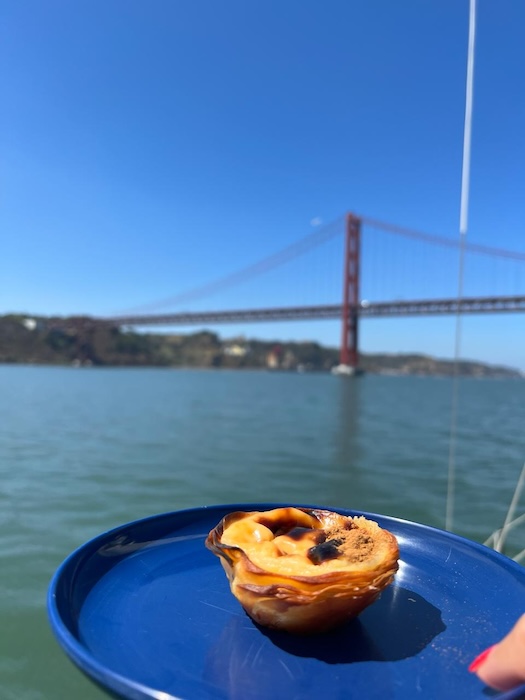
Where to Eat and Drink in Lisbon
From one indulgence to the next! Lisbon’s thriving food scene is a tapestry of fresh seafood, classic Portuguese dishes like Bacalhau à brás (salted cod fish, potatoes, and eggs) and Pastel de Nata (Portuguese custard tarts), and refreshing takes on global cuisine.
Pastéis de Belém is a well-loved Portuguese egg tart shop and cafe situated in the Belém district of Lisbon. Established in 1837, the bistro is frequented by locals and tourists for its lip-smacking pastéis de nata. These mouth-watering tarts are crafted using a secret family recipe that has been passed down through the generations. Pastéis de Belém’s tarts feature a perfectly flaky puff pastry crust and an indulgent, creamy egg custard filling.
Geographia is an intimate restaurant near some of Lisbon’s most popular districts. It serves Portuguese dishes along with dishes from all the former Portuguese colonies such as Goa, Mozambique, Angola, and Brazil.
Time Out Market Lisboa is an expansive, upscale food hall set in the historic Mercado da Ribeira, a traditional market built in the 1890s in Lisbon’s Cais do Sodré waterfront district. Unveiled in 2014, the Time Out Market is home to over four dozen eateries, bars, and shops, showcasing some of the finest food experiences in the city. I ate some delicious seafood at Marisqueira Azul and fresh pasta at Libertà Pasta Bar. Time Out Market Lisboa is also a great place to people-watch!
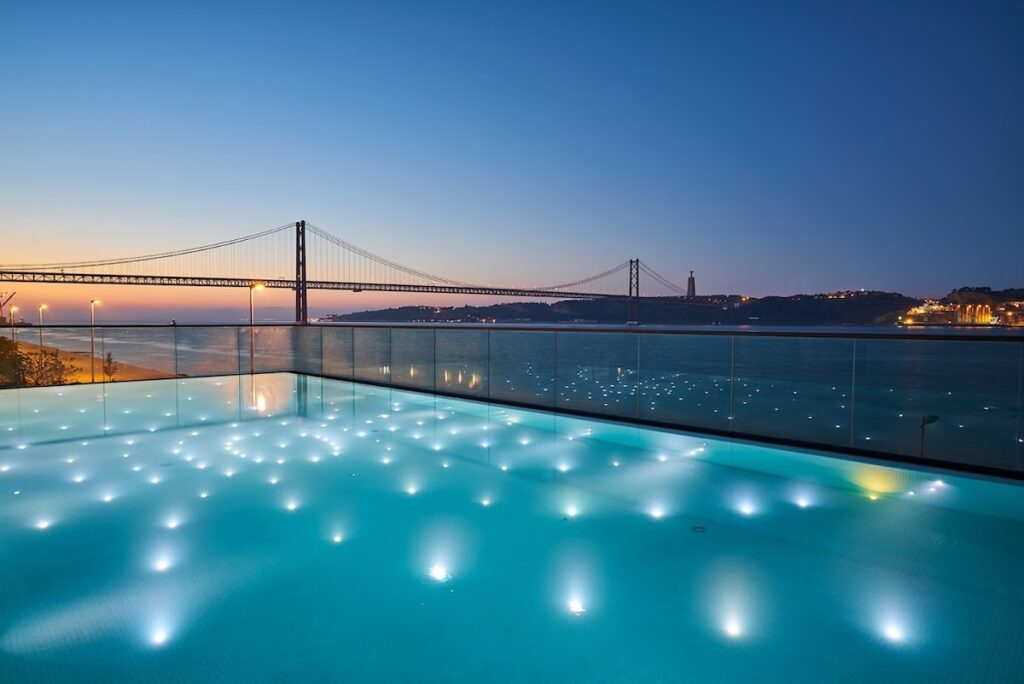
SUD Lisbon Terrazza is a trendy restaurant and lounge that overlooks the majestic 25th of April Bridge and the Sanctuary of Christ the King statue. This riverside eatery houses a number of dining areas, a rooftop infinity pool, and a lounge. Designed by the leading architect Antoine Pinto, the lively eatery’s interiors are a mix of traditional and modern. The restaurant serves fresh Mediterranean dishes made with the freshest local ingredients. After your meal, make your way to the rooftop SUD Pool Lounge for live musical performances and awe-inspiring vistas.
During the day, you can indulge in tapas-style petiscos (snacks) in sophisticated cafes and dine at inviting fine-dining restaurants. And when the sun bids adieu to the day, Lisbon transforms into a party city, with lively bars whipping up innovative cocktails and spirited nightclubs keeping the beat going until dawn.
For the ultimate nightlife playground, make your way to Bairro Alto, the historic center of Lisbon’s nightlife. This district is full of casual bars and pubs, as well as renowned nightclubs. However, Lisbon’s party scene isn’t all about bar hopping and energetic nightclubs. Alfama is perfect for a relaxed evening with live Fado performances. I experienced an unforgettable authentic Portuguese meal and Fado show at Mesa de Frades in Alfama. Fado, a melancholic music genre from 1820s Lisbon, is loved for its deeply emotional lyrics.
Where to Stay in Lisbon
If all these entertainment options hadn’t sealed the deal already, the city’s luxurious hotels offering impeccable hospitality, surely will. I’ve had the opportunity to stay at three distinctive hotels in Lisbon. Each of the properties is situated in well-known tourist areas of the city and provides thoughtful service.
LUXURY STEEPED IN HISTORY – Four Seasons Lisbon
Located in the heart of the city, this historic property features a blend of Art Deco and Louis XVI-style interiors. The property offers guests the perfect blend of modern luxurious and old-world charm. The hotel is also situated close to many of Lisbon’s tourist attractions, such as São Jorge Castle and Jerónimos Monastery. It was built in the 1950s and boasts aesthetically pleasing interiors, arresting décor, warm hospitality, and panoramic vistas of the city’s skyline. The Ritz Four Seasons Lisbon is also home to a range of well-appointed amenities, including an outdoor running track, a spa, and an indoor lap pool. The hotel’s guest rooms are just as exquisite, with several featuring private balconies or expansive terraces. The Ritz Four Seasons’s eateries — Varanda and O Japonês are also worth checking out!
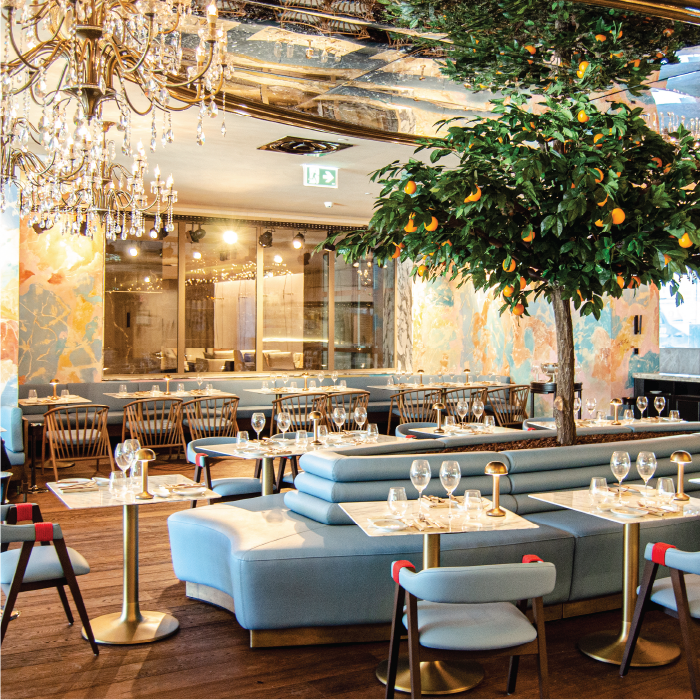
CHIC AND MODERN – EPIC SANA Marquês
EPIC SANA Marquês is a sumptuous hotel situated near both the business district and the historic city center, making it a good choice for leisure or business travelers. The property features 379 well-furnished rooms and suites. Each guest room is equipped with state-of-the-art appliances and visually arresting yet functional furnishings. I recommend checking out the hotel’s Sayanna Wellness Spa, which has an indoor vitality pool, a sauna, welcoming treatment rooms, and offers a range of relaxing services. Also, go for a sunset swim at the hotel’s rooftop pool and dine at Allora, the glamorous Italian bistro!
RIVERSIDE MODERN GETAWAY – Myriad By SANA Hotels
If you’re looking for a more quiet stay, choose Myriad By SANA Hotels, a contemporary hotel, set alongside the Tagus River and Parque das Nações. This hotel offers 186 elegant guest rooms and suites, all of which feature floor-to-ceiling windows that provide unobstructed vistas of the city or the river. I suggest dining at the hotel’s signature restaurant, FIFTY SECONDS by Martin Berasategui, which is a Michelin-starred restaurant that serves an immersive tasting menu of contemporary Basque cuisine. Furthermore, the property’s spa, which is on the 23rd floor, offers a luxurious escape from the city’s bustle. Breathtaking vistas of the Tagus River create a calming ambiance for treatments and rejuvenation.
Day Trips from Lisbon
Lisbon is surrounded by many historic towns, charming villages, and pristine beaches, all within easy reach of the capital city. I recommend taking a day trip from Lisbon to experience the region’s breathtaking natural landscapes. You can rent a car, take public transportation, or join a guided tour.
The regal National Palace of Queluz was the erstwhile residence of the Portuguese royal family. About a 15-minute drive away from Lisbon, the palace is now a museum. It showcases baroque, rococo, and neoclassical architectural styles and houses well-manicured gardens with beautiful water features. This magnificent palace will transport you back to a time of exquisite royal balls and over-the-top stately dinners.
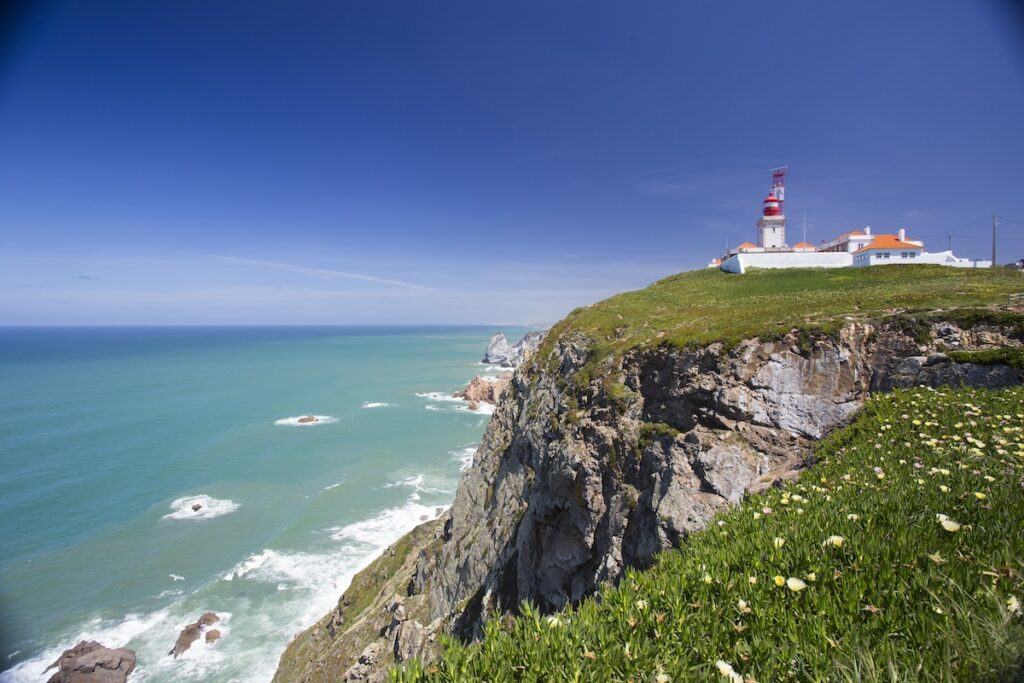
A beautiful seaside town, Cascais is an excellent place to unwind on the beach, go for a swim, or try surfing. In Cascais, the Citadel of Santa Marta, a 16th-century fortress, and the Boca do Inferno, a natural rock formation, are also worth checking out.
Sintra is a quaint town, which is a short 30-minute drive from Lisbon. It’s home to majestic palaces, lush green forests, and untouched beaches. In Sintra, visit the Pena National Palace, the castle Quinta da Regaleira, which is a UNESCO World Heritage Site, and the Moorish Castle which offers spectacular vistas of the area. To immerse yourself further in the area’s unspoiled charms, escape to the tranquil Cabo da Roca, a dramatic cliffside location that is considered the westernmost point of continental Europe. It’s about a 40-minute drive west of Lisbon and provides one-of-a-kind views of the Atlantic Ocean.
Things to keep in mind in Lisbon
What to wear: The weather in Lisbon changes drastically through the day, so always wear layers that you can remove or add. Pack light jackets, sweaters, long-sleeved shirts, and flowy dresses or pants. Most of all, pack comfortable walking shoes as the city is famous for its steep streets.
Dining etiquette: Always tip servers 5-10 percent, depending on the quality of service.
Drinking water: Lisbon’s water is safe to drink directly from all faucets and water fountains across the city. At restaurants, tap water is free of cost and is also safe to drink.
Transport: It’s not advisable to rent a car while visiting Lisbon. The city is walking-friendly and is well-connected by the metro, trams, and buses. Ubers, Lyfts, and taxis are easily available and affordable as well.
Best time to visit: Year-round pleasant weather in Lisbon means that any time is a good time to visit. But if you want to avoid the crowds, fall and spring are best.
